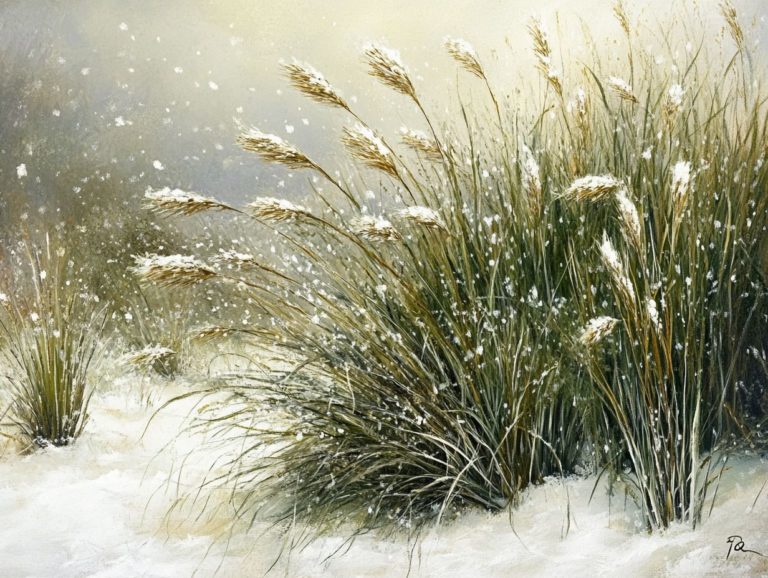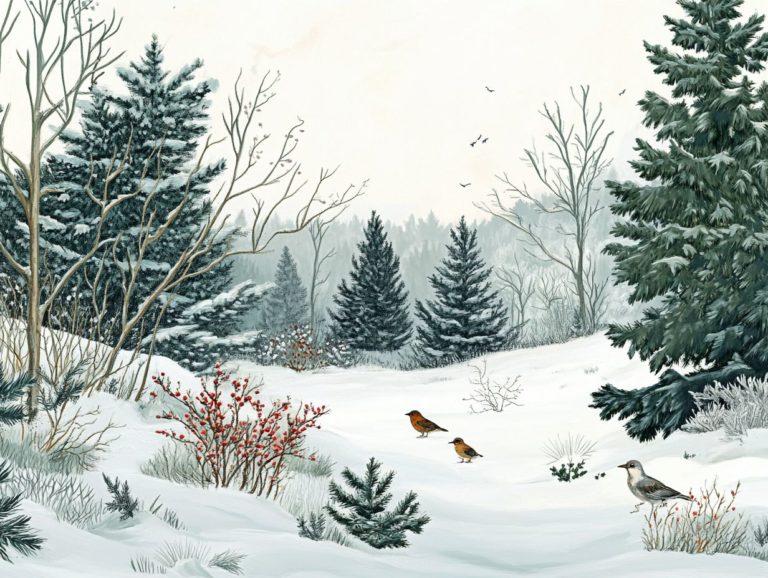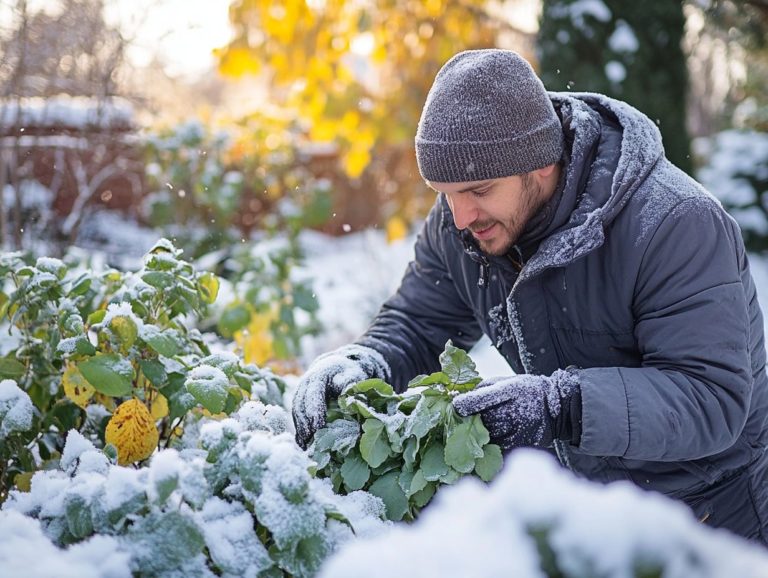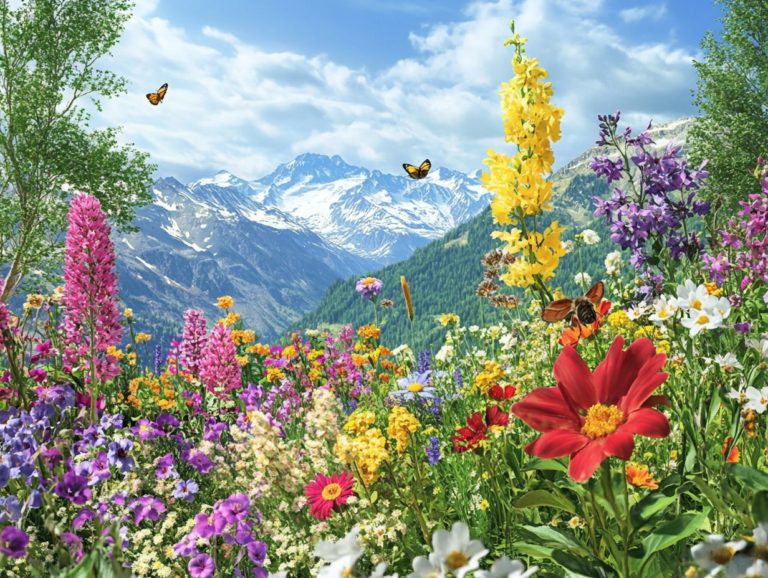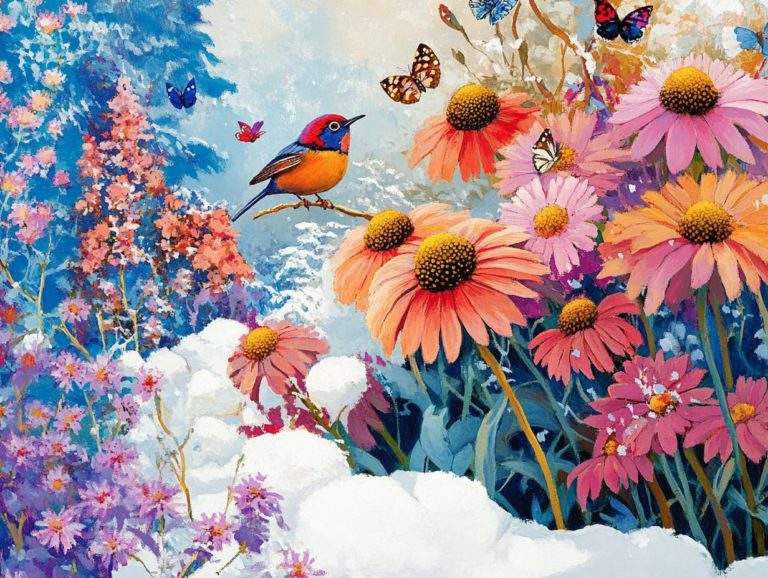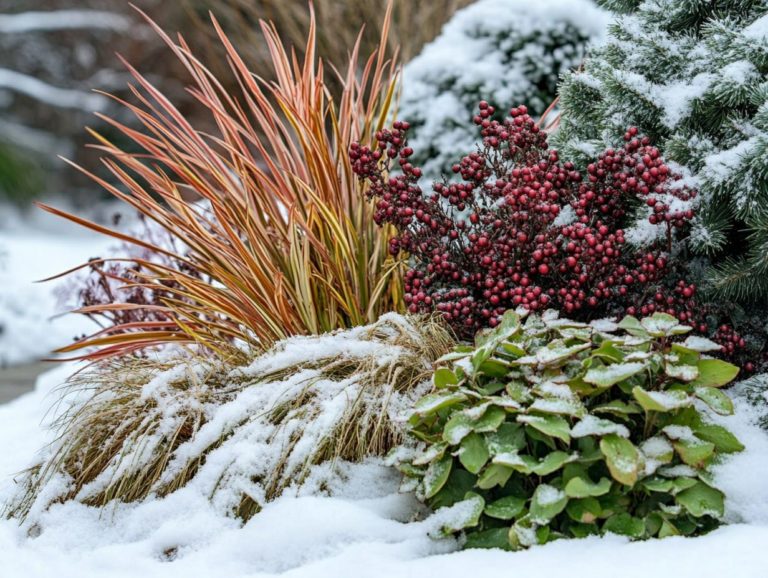Best Plants for Cold-Climate Wildflower Gardens
Creating a wildflower garden in a cold climate, such as Montana, might seem daunting at first. However, with the right knowledge and techniques, you can cultivate a breathtaking array of blooms that flourish in cooler temperatures.
This guide will take you through every step of the process. You will learn how to select the ideal location, understand your garden’s unique growing conditions, choose the best wildflower species, and care for them properly.
Get ready to uncover the amazing benefits of incorporating native plants and easy-to-grow varieties. You ll also discover how to attract pollinators and extend your garden s blooming season. Whether you re a seasoned gardener or just beginning, you ll find valuable tips to help your cold-climate wildflower garden thrive beautifully.
Contents
- Key Takeaways:
- 1. Choosing the Right Location for a Wildflower Garden
- 2. Understanding the Growing Conditions of Cold-Climate Gardens
- 3. Best Wildflower Species for Cold-Climate Gardens
- 4. Tips for Planting a Successful Wildflower Garden in a Cold Climate
- 5. Maintenance and Care for Cold-Climate Wildflower Gardens
- 6. Dealing with Common Pests and Diseases in Cold-Climate Wildflower Gardens
- 7. Incorporating Native Plants in a Cold-Climate Wildflower Garden
- 8. Using Wildflowers for Attracting Pollinators in Cold-Climate Gardens
- 9. Creating a Colorful and Vibrant Wildflower Garden in a Cold-Climate: Tips for Ohio and Montana
- 10. Extending the Blooming Season in Cold-Climate Wildflower Gardens: Best Practices
- 11. Incorporating Edible Wildflowers in a Cold-Climate Garden: A Culinary Delight
- 12. Using Wildflowers for Erosion Control in Cold-Climate Gardens: Best Practices
- 13. Top Companion Plants to Boost Your Cold-Climate Wildflower Garden
- 14. Incorporating Wildflowers in Different Garden Designs for Cold-Climate Areas: Aesthetic and Functional
- 15. Common Mistakes to Avoid When Planting a Cold-Climate Wildflower Garden: Tips for Success
- What Are the Benefits of Planting a Wildflower Garden in a Cold Climate? Exploring the Advantages
- How Can Wildflowers Enhance the Aesthetic Appeal of a Cold-Climate Garden?
- What Are the Best Practices for Maintaining a Wildflower Garden in a Cold Climate?
- Frequently Asked Questions
Key Takeaways:
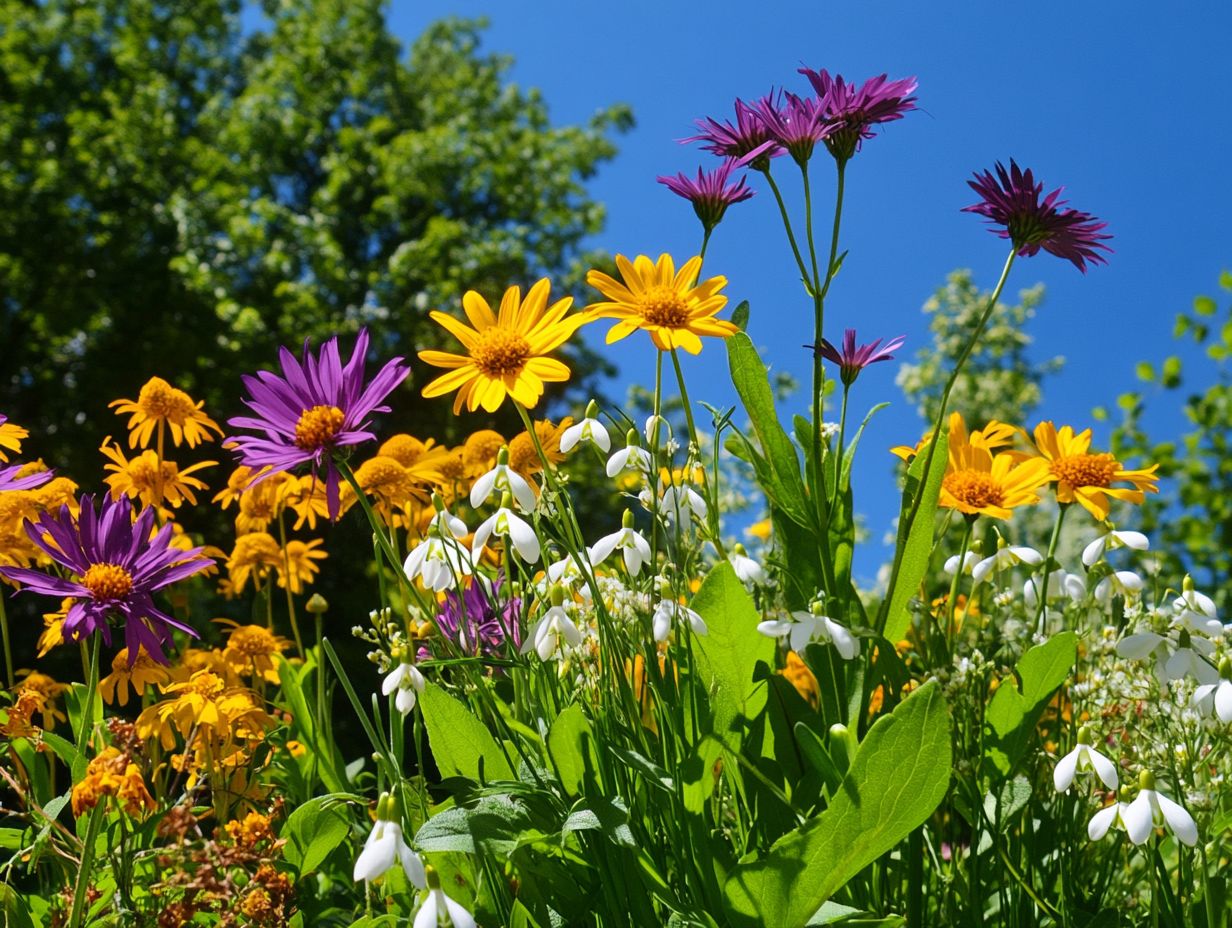
- Choose the best location and understand your garden’s growing conditions for a thriving wildflower garden.
- Incorporate native and companion plants, including fragrant flowers, to enhance the aesthetic appeal and attract pollinators.
- Extend the blooming season, control erosion, and include edible wildflowers for environmental conservation and added benefits.
1. Choosing the Right Location for a Wildflower Garden
Selecting the right location for your wildflower garden in Montana is crucial for ensuring robust plant growth and vibrant blooms. The region’s cold climate and specific hardiness zone requirements make this choice even more important.
Choose a spot that offers ample sunlight and well-draining topsoil. Protection from harsh winds is also essential to nurture a thriving ecosystem of perennial and annual wildflowers, including fragrant blooms and drought-resistant varieties.
When considering placement, think about sunlight exposure. Most wildflowers flourish in full sun for at least six hours each day. Proper water drainage is also essential to prevent root rot and encourage healthy growth, directly impacting the garden’s long-term sustainability.
Finding a sheltered area can protect your plants from strong winds and enhance their resilience. These elements not only support the flourishing of native species but also contribute to soil health and attract pollinators, enriching the overall ecological balance of your space.
2. Understanding the Growing Conditions of Cold-Climate Gardens
Gardening in a cold climate requires understanding specific growing conditions, particularly the hardiness zone a way to identify which plants can survive in your area s climate. For gardeners in regions like Montana, choosing frost-tolerant varieties for summer blooms is essential.
Recognizing these zones influences your plant selection and impacts the likelihood of successful harvests. Selecting plants suited to colder hardiness zones ensures they can endure harsh winters while still delivering vibrant flowers and delicious produce during warmer months.
Enhancing soil quality through techniques such as adding organic matter and establishing proper drainage creates optimal growth conditions. This is especially crucial in cold climates where soils may be dense or poorly aerated.
These preparations lead to healthier root systems and, ultimately, stronger plants capable of flourishing even under challenging weather conditions.
3. Best Wildflower Species for Cold-Climate Gardens
Choose wildflower species suited for your cold-climate garden. Look for both perennial and annual varieties that can withstand harsh conditions. This ensures a vibrant display and supports local ecosystems. Consider the best plants for small cold-climate gardens, like Echinacea and Lavandula angustifolia, which produce stunning blooms in summer and attract pollinators.
Species such as Aquilegia canadensis and Rudbeckia hirta thrive in cooler temperatures. They add color and resilience to your landscape. The hardiness of these plants enhances your garden s aesthetic appeal and provides habitats for bees, butterflies, and other pollinators, ultimately boosting biodiversity.
As you plan, integrate annuals like Calendula officinalis. These are known for their extensive summer blooms and pair beautifully with sturdy perennials. This thoughtful mix guarantees continuous beauty throughout the seasons.
By fostering a balanced garden ecosystem with non-woody plants, you can improve soil health and attract beneficial insects. This creates a thriving outdoor sanctuary that you’ll love!
4. Tips for Planting a Successful Wildflower Garden in a Cold Climate
Successfully establishing a wildflower garden in a cold climate requires thoughtful planning and execution. Key tips include timing your seed germination, considering direct sowing versus transplanting, and using floating row covers to protect seedlings from frost. Incorporating plants for wildlife habitat in cold climates can also enhance your garden’s ecological benefits.
Timing is crucial. Sow seeds in early spring, after the last frost, to establish roots as temperatures stabilize. If you’re new to gardening, select easy-to-grow species like asters or black-eyed Susans. They re beginner-friendly and promise a vibrant display.
To enhance seed germination, soak seeds overnight. This speeds up the process and boosts the germination rate. Protect your young plants with a layer of mulch. It provides insulation, retains moisture, and keeps weeds at bay, creating the perfect growth environment.
5. Maintenance and Care for Cold-Climate Wildflower Gardens
Maintaining a wildflower garden in a cold climate requires ongoing care and attention, especially for robust and drought-resistant varieties. For optimal results, consider selecting plants for cold-climate rain gardens to ensure your garden flourishes despite seasonal changes and the risk of self-sown plants overtaking the area.
Regular watering is essential, particularly during dry spells when even hardy plants struggle. Weeding is equally important; it preserves the health of your blooms by preventing nutrient theft from competing species. Support self-sown plants to enrich your garden s biodiversity, but stay vigilant to prevent them from dominating.
Adjust your care routines with the seasons. Mulch in winter to protect roots and apply light fertilizer in early spring to promote strong growth. By selecting plants that withstand harsh conditions, you’ll enjoy a vibrant display that demands less intensive care over time.
6. Dealing with Common Pests and Diseases in Cold-Climate Wildflower Gardens
Common pests and diseases present challenges for your wildflower garden in cold climates, especially those affecting brugmansia and cannas. Developing effective management strategies tailored to the unique varieties in these regions is essential.
These gardens often face threats from pests like aphids, which sap the vitality of delicate blooms, and caterpillars, which munch on leaves, diminishing plant health. Fungal diseases, such as powdery mildew, may also appear, particularly in humid conditions, leading to unsightly foliage and stunted growth.
Combat these issues with organic solutions. Introduce beneficial insects like ladybugs to keep aphid populations in check. Use neem oil to fend off fungal infestations.
- Introduce beneficial insects like ladybugs to control aphids.
- Use neem oil to prevent fungal infestations.
Maintain good air circulation and ensure proper spacing between your plants, including morning glory and other climbing varieties. This creates an environment unfavorable for disease, allowing your beautiful wildflowers to flourish even in cold climates!
7. Incorporating Native Plants in a Cold-Climate Wildflower Garden
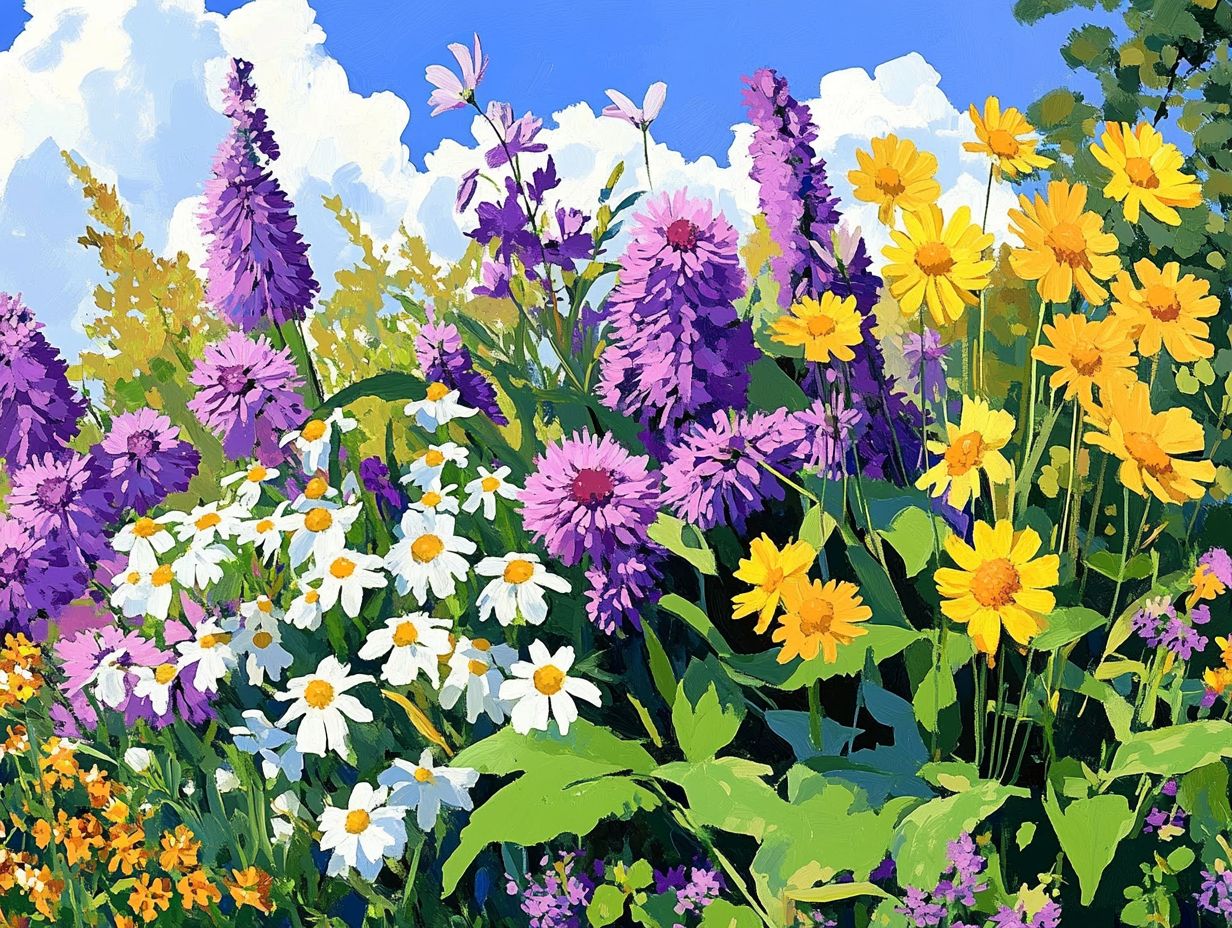
Incorporating native plants into your cold-climate wildflower garden not only elevates its aesthetic charm but also helps the local ecosystem and supports a variety of plants and animals. This practice is essential for anyone gardening in regions like Montana.
These native plants are perfectly tailored to thrive in the local climate, soil types, and weather patterns. This means you ll spend less time on maintenance and fewer resources compared to non-native varieties. By selecting native species, you can cultivate a sustainable environment that provides food and habitat for pollinators and wildlife elements crucial for maintaining ecological balance.
Take, for example, native wildflowers like purple coneflower and blanket flower. They thrive even in colder temperatures and attract beneficial insects such as bees and butterflies. These plants also enhance soil health and help prevent erosion, making them a wise choice for anyone wanting to create a flourishing garden while being environmentally responsible.
8. Using Wildflowers for Attracting Pollinators in Cold-Climate Gardens
Using wildflowers in your cold-climate garden is a fantastic way to attract pollinators, which are crucial for maintaining a healthy ecosystem. Incorporating fragrant flowers can be particularly effective in drawing in bees and butterflies!
By selecting species like coneflowers, black-eyed Susans, and goldenrods, you can craft a vibrant landscape that enhances visual appeal while providing a sanctuary for various beneficial insects. These wildflowers bloom at different times, ensuring a continuous food source throughout the growing season.
To further support these invaluable creatures in your cold-climate garden, consider implementing strategies such as:
- Avoiding pesticides
- Incorporating native plants
- Providing nesting habitats
- Utilizing hardiness zone resources to choose appropriate species
By nurturing a diverse and resilient garden, you can cultivate an ecosystem where pollinators thrive, benefiting not only your garden but also the surrounding environment.
9. Creating a Colorful and Vibrant Wildflower Garden in a Cold-Climate: Tips for Ohio and Montana
Creating a vibrant wildflower garden in a cold climate demands your careful selection of plant varieties, including the best plants for windy cold-climate gardens, that deliver bright colors and extended blooming periods. This ensures a breathtaking display throughout the summer months.
Consider the growth habits and heights of your plants. Layering taller varieties with shorter flowering species adds depth and dimension, enhancing the overall aesthetic. A mix of perennials, like bearded irises, and annuals not only prolongs the blooming season but also guarantees a delightful burst of colors at various growth stages.
Embracing diversity in your plant selection is vital; it invites a host of pollinators, fosters ecological balance, and cultivates a lively environment that captures the eye.
By thoughtfully arranging your plants, you can achieve a harmonious palette that evolves beautifully with the seasons.
10. Extending the Blooming Season in Cold-Climate Wildflower Gardens: Best Practices
Let s extend the blooming season in your cold-climate wildflower garden! It’s essential to prioritize the selection of frost-tolerant species like Achillea millefolium, which are plants that can survive cold temperatures without damage, while implementing practices that promote continuous growth and vibrant blooms from spring to fall.
This means carefully choosing plants that not only thrive in cooler temperatures but also feature staggered blooming periods. This ensures that there s always something lively and colorful gracing your garden. Consider a blend of early, mid, and late bloomers to create a seamless tapestry of colors throughout the growing season.
Utilizing protective techniques, like floating row covers, can safeguard delicate young plants from unexpected frosts and pests, allowing them to establish robust growth. By incorporating these strategies, you can significantly enhance the beauty and longevity of your wildflower display.
11. Incorporating Edible Wildflowers in a Cold-Climate Garden: A Culinary Delight
Incorporating edible wildflowers into your cold-climate garden not only elevates its diversity but also opens up a world of unique culinary possibilities. Imagine tasting the vibrant flavors and seeing the bright colors of plants like flowering tobacco, nasturtium, and marigold.
These lively additions can be used in salads, as stunning garnishes, or even brewed into herbal teas. They provide both visual allure and nutritional benefits. For those living in chillier regions, varieties like chive blossoms, violets, and dandelions thrive beautifully, adding a cheerful burst of color and taste.
Taking care of these hardy plants requires well-drained soil, ample sunlight, and consistent watering to help the plants grow well. Integrating them into your existing garden beds or allowing them to roam as free-spirited border plants creates a picturesque landscape. This landscape invites beneficial pollinators, such as bees and butterflies, enriching the overall ecosystem.
12. Using Wildflowers for Erosion Control in Cold-Climate Gardens: Best Practices
Employing wildflowers for erosion control in your cold-climate garden is a brilliant strategy. It helps maintain soil integrity while enhancing the aesthetic appeal of your landscape, especially when combined with proper soil preparation and planting techniques.
Selecting wildflower species with deep or fibrous root structures is essential. These roots anchor the soil and promote water absorption, which ultimately reduces runoff. For the best results, consider native species that thrive in your local conditions to ensure better survival rates and less maintenance over time.
When planting, be mindful of spacing the flowers appropriately. This allows them to grow naturally and maximizes their stabilizing effects. Regular maintenance, including effective weed control and mulching, is important for bolstering the health of your wildflowers, paving the way for successful erosion control in the long run.
13. Top Companion Plants to Boost Your Cold-Climate Wildflower Garden
Choosing the right companion plants for your cold-climate wildflower garden is key to fostering biodiversity and enhancing the overall health of your garden ecosystem. For more tips, consider choosing plants for a cold-climate rock garden, as it’s crucial to select plants that work harmoniously together.
Take yarrow and milkweed, for example. They not only add visual appeal but also attract beneficial insects like ladybugs and pollinators. These companions can help keep pest populations in check and create a balanced environment.
Consider adding clover as well; it improves soil health by adding nutrients, benefiting the root systems of your wildflowers. By closely monitoring and nurturing each species, you can enhance their natural synergies, resulting in a vibrant and resilient garden.
This thoughtful approach to companion planting ensures that your wildflowers thrive, supported by their companions in both growth and sustenance, ultimately benefiting the local ecosystem.
14. Incorporating Wildflowers in Different Garden Designs for Cold-Climate Areas: Aesthetic and Functional
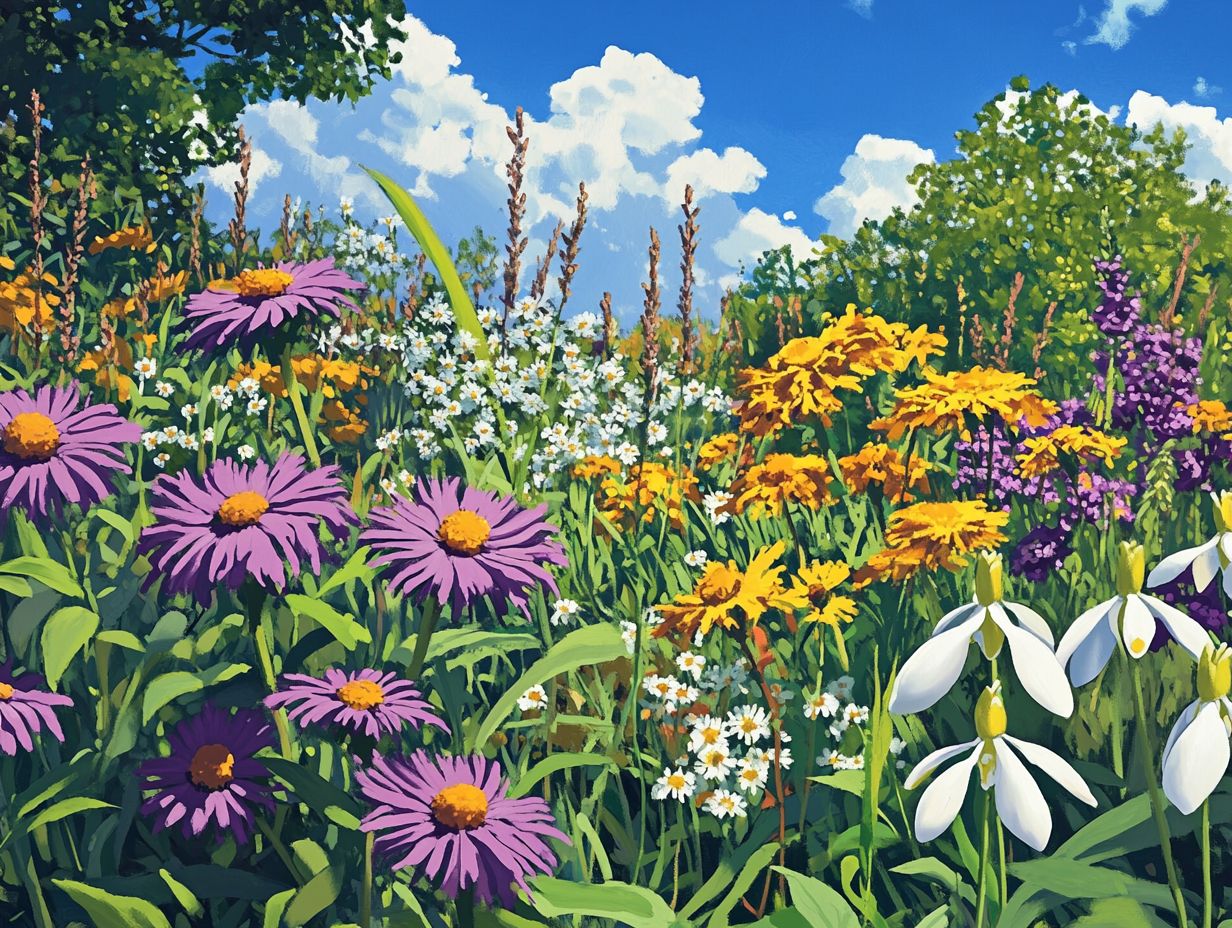
Incorporating wildflowers into your garden designs for cold-climate areas opens up a world of creative landscaping possibilities while respecting specific environmental conditions. Additionally, using perennial herbs for cold-climate gardens enhances both the beauty and functionality of your outdoor spaces.
Your designs can range from charming cottage gardens, where wildflowers elegantly mingle with traditional perennials, to expansive meadows that evoke a natural, serene ambiance. When planning your planting styles, it s essential to choose native wildflower species that thrive in the local soil and climate, ensuring they remain resilient and vibrant throughout the seasons.
By layering different heights and textures, you can significantly enhance the visual appeal of your garden. This attracts pollinators and enriches the local ecosystem. Each style not only adds aesthetic diversity but also serves a practical purpose, making your outdoor spaces more inviting and sustainable.
15. Common Mistakes to Avoid When Planting a Cold-Climate Wildflower Garden: Tips for Success
Avoiding common mistakes when planting a cold-climate wildflower garden is essential for creating a thriving and vibrant landscape. To enhance your success, consider choosing the right plants for cold climates, as missteps can lead to disappointing plant performance, particularly in regions with challenging conditions.
To achieve that lush display you’ve envisioned, pay close attention to soil preparation a critical step that many gardeners often overlook. Testing the soil pH and texture will help you determine if any amendments are needed to create the perfect environment for your wildflowers.
Choosing plants that aren’t well-suited for your local conditions can lead to disappointment, so take the time to research and select native species. This choice can significantly enhance your garden’s resilience. By incorporating these practical strategies, you’ll cultivate a flourishing ecosystem that beautifully showcases the region’s flora.
What Are the Benefits of Planting a Wildflower Garden in a Cold Climate? Exploring the Advantages
Planting a wildflower garden in a cold climate presents you with a wealth of benefits, such as more types of plants and animals, better habitats for pollinators, and the creation of a resilient ecosystem that flourishes in challenging conditions. Choosing the best plants for shade gardens in cold climates is vital for regions like Ohio and Montana.
Your garden can also transform landscapes, offering a visual feast that evolves with the changing seasons. It fills your surroundings with vibrant colors and diverse textures that uplift the local environment. By incorporating native species, you not only provide vital food sources for birds and insects but also foster a harmonious balance between flora and fauna.
Diverse plantings not only brighten your garden but also improve soil health and prevent erosion, contributing to long-term ecological resilience. For example, introducing specific native blooms can enrich the habitat by attracting beneficial insects like bees and butterflies, which play a crucial role in pollination and maintaining the health of the overall ecosystem.
How Can Wildflowers Help with Environmental Conservation in Cold-Climate Areas? Understanding Their Role
Wildflowers play a pivotal role in environmental conservation in cold-climate areas. They provide essential habitats for wildlife, enhance biodiversity, and contribute to the overall health of local ecosystems, making them a crucial part of sustainable gardening.
These vibrant plants not only brighten your surroundings but also improve soil quality by preventing erosion and enriching it with organic matter as they gracefully die and decompose. Their deep root systems work wonders, promoting water retention to keep the landscape hydrated, especially during dry spells.
By creating a rich tapestry of blooms, wildflowers attract a variety of pollinators bees, butterflies, and hummingbirds love them. Wildflower gardens become sanctuaries for small critters, enhancing the food web and supporting the delicate balance necessary for thriving habitats.
What Are the Benefits of Using Native Plants in a Cold-Climate Wildflower Garden?
Utilizing native plants in your cold-climate wildflower garden offers a wealth of benefits that go beyond mere aesthetics. By choosing plants for a cold-climate pollinator garden, you’ll promote biodiversity, enhance resilience in local conditions, and cultivate a thriving ecosystem that supports native pollinators and wildlife.
These plants have spent years adapting to specific soils and fluctuating weather patterns, allowing them to flourish with minimal effort on your part. Unlike their non-native counterparts, which often demand extra resources for irrigation and care, native species are naturally inclined to conserve water and endure harsh conditions.
Their deep root systems not only help prevent soil erosion but also improve the process of nutrients moving through the ecosystem, contributing to a healthier environment. By supporting local wildlife, these plants provide essential habitats and food sources for a variety of species, fostering a balanced ecosystem where insects, birds, and other organisms can thrive in harmony.
Don t wait! Start planning your cold-climate wildflower garden today for a vibrant tomorrow!
How Can Wildflowers Enhance the Aesthetic Appeal of a Cold-Climate Garden?
Wildflowers elevate the charm of cold-climate gardens, adding vibrant colors, varied textures, and dynamic shapes that captivate the eye, creating a lively landscape throughout the growing season.
By selecting species that bloom at different times, you can ensure a constant visual feast. This approach transforms dull patches into breathtaking displays. Clustering wildflower varieties creates striking bursts of color, while layering taller blooms behind shorter ones adds inviting depth to your garden design.
Whether you re cultivating a charming cottage-style garden or a more structured landscape, native plants blend seamlessly into your overall theme. They encourage pollinators and add a delightful sense of natural whimsy that enriches any outdoor space.
What Are the Best Practices for Maintaining a Wildflower Garden in a Cold Climate?
Maintaining a wildflower garden in a cold climate requires embracing best practices that promote plant health and vibrancy. Key aspects include regular monitoring, proper watering techniques, and seasonal adjustments to your care routine.
Regular pruning cutting back plants to encourage new growth is essential. It helps eliminate any dead or diseased stems that could hinder your garden’s beauty. Weeding is another critical task; it prevents unwanted plants from competing for the nutrients and space your wildflowers deserve.
Seasonal preparations like mulching in the fall or dividing perennials in the spring help your garden flourish throughout the year. Tailoring your techniques to the specific varieties of wildflowers you cultivate is key, as each may have unique care requirements and resilience to local weather conditions.
Frequently Asked Questions
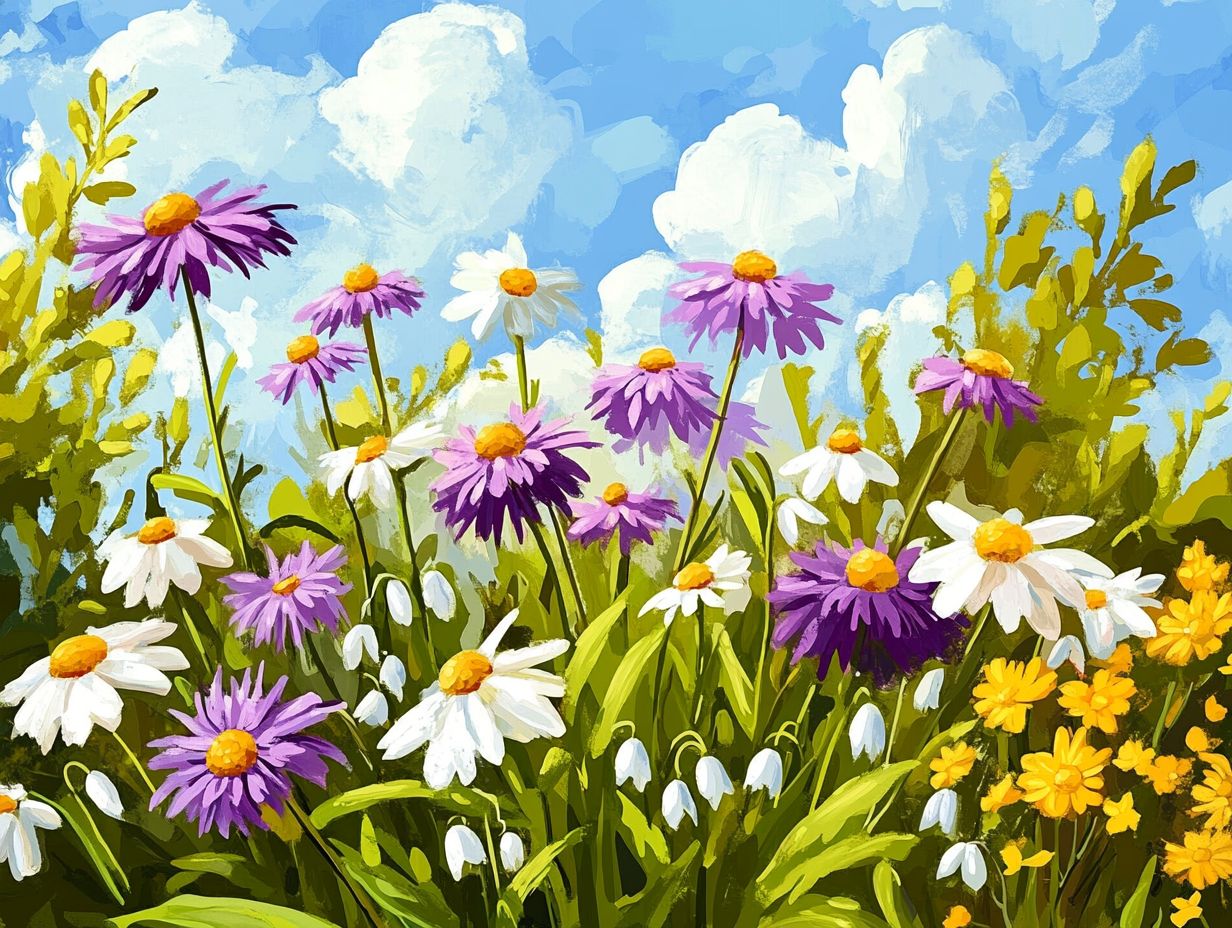
What are the best plants for cold-climate wildflower gardens?
Some of the best plants include asters, coneflowers, columbines, lupines, and black-eyed Susans.
Do these plants require a lot of maintenance?
Most of these plants are low-maintenance and easy to grow. They may need occasional pruning and deadheading, but overall, they are fairly self-sufficient.
Can I plant these wildflowers in the fall?
Yes, planting in the fall is ideal. This allows the plants to establish their roots over the winter and bloom in the spring.
Will these plants attract pollinators?
Yes, these wildflowers attract pollinators such as bees and butterflies, making them beautiful and beneficial to the environment.
What type of soil do these plants prefer?
These plants thrive in well-drained, moist soil with a neutral pH. They can tolerate some dry periods, making them adaptable to various soil types.
How long do these wildflowers typically bloom for?
The blooming period varies, but on average, they bloom for 4-6 weeks. Some may have longer blooming periods, while others may bloom multiple times throughout the growing season.
Start planning your wildflower garden today for a vibrant and beautiful outdoor space!

